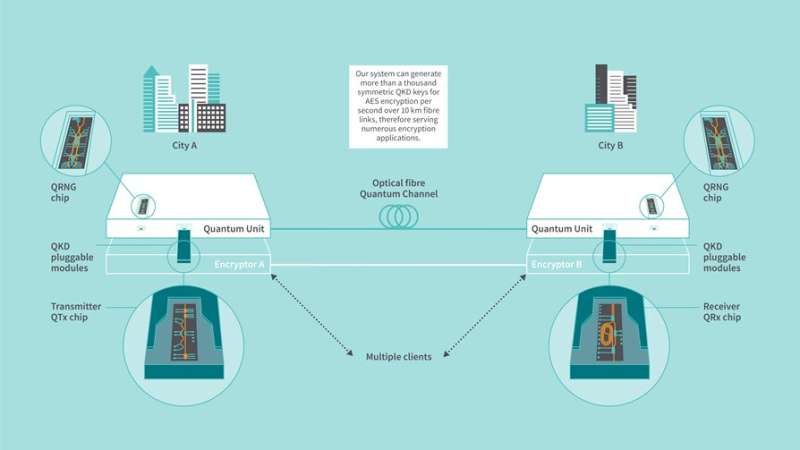Figure 1: A QKD chip being tested at Toshiba’s Cambridge Research Laboratory Figure 2: Prototype of an optical integrated circuit and a chip-based quantum cryptography communication system. (Top row, from left: quantum transmitter chip, quantum receiver chip, quantum random number generator chip. Bottom row: chip-based quantum cryptography communication system). Photo credit: Toshiba Corporation
Toshiba Europe Ltd announced today that it has developed the world’s first chip-based quantum key distribution system (QKD). This advancement will enable the mass production of quantum security technology and bring its application to a much wider range of scenarios, including Internet of Things (IoT) solutions.
QKD addresses the demand for cryptography that remains secure from attacks by the supercomputers of tomorrow. In particular, a large quantum computer will be able to efficiently solve the difficult mathematical problems that are the basis of today’s widely used public key cryptography for secure communication and e-commerce. In contrast, the protocols used for quantum cryptography can be proven to be secure from the first principles and are not susceptible to attack by a quantum computer, or even just one computer in the future.
The QKD market is expected to grow to around $ 20 billion worldwide in fiscal 2035. Large quantum-secured fiber optic networks are currently under construction in Europe and Southeast Asia, and there are plans to launch satellites that can expand the networks on a global scale. In October 2020 Toshiba released two products for fiber-based QKD based on discrete optical components. Together with project partners, Toshiba has implemented quantum-secured metro networks and long-distance fiber optic backbone connections in Great Britain, Europe, the USA and Japan.
Manufacturing advances
In order for quantum cryptography to become as ubiquitous as the algorithmic cryptography we use today, it is important that the size, weight and power consumption continue to be reduced. This applies in particular to the expansion of QKD and quantum random number generators (QRNG) into new domains such as the last-mile connection to the customer or the IoT. The development of chip-based solutions is essential to enable mass market applications that will be essential to the realization of a quantum capable economy.
Toshiba has developed techniques to reduce the optical circuitry used for QKD and QRNG into tiny semiconductor chips. Not only are these significantly smaller and lighter than their fiber optic counterparts, they also consume less electricity. Most importantly, many can be manufactured in parallel on the same semiconductor wafer using standard techniques used in the semiconductor industry, which enables them to be manufactured in much larger quantities. The quantum transmitter chips developed by Toshiba, for example, measure only 2×6 mm, so that several hundred chips can be produced on one wafer at the same time.
Andrew Shields, Head of Quantum Technology at Toshiba Europe, commented, “Photonic integration will enable us to manufacture quantum security devices with high reproducibility in large quantities. Introducing QKD into a larger part of the telecommunications and data communications network.”

Overview of a chip-based quantum cryptography communication system. Photo credit: Toshiba Corporation
Taro Shimada, Corporate Senior Vice President and Chief Digital Officer of Toshiba Corporation, commented: “Toshiba has invested in quantum technology research and development in the UK for over two decades ubiquitous quantum security devices. ”
The details of the further development are published in the journal Nature Photonics.
Technical summary
QKD systems typically include complex fiber optic circuitry that integrates discrete components such as lasers, electro-optic modulators, beam splitters, and fiber couplers. Because these components are relatively bulky and expensive, the purpose of this work was to develop a QKD system in which the fiber optic circuit and components are written in millimeter-scale semiconductor chips.
Toshiba has developed the first complete QKD prototype using quantum photonic chips with different functionality. Random bits for preparing and measuring the qubits are generated in quantum random number generator (QRNG) chips and in real time in high-speed modulation patterns for the chip-based QKD transmitter (QTx) and receiver (QRx) with field-programmable gate arrays (FPGAs). Photons are detected using fast gate single photon detectors. Viewing, evaluating the photon statistics, time synchronization and phase stabilization are carried out via an optical 10 Gb / s connection between the FPGA cores, which enables autonomous operation over longer periods of time. As part of the demonstration, the Chip-QKD system was connected to a commercial encryptor that enables secure data transmission at a bit rate of up to 100 Gbit / s.
To promote integration in conventional communication infrastructures, the QKD units are mounted in compact 1U rackmount housings. The QRx and QTx chips are packaged in C-Form-Factor-Pluggable-2-Modules (CFP2), a widely used form factor in coherent optical communication, to ensure the forward compatibility of the system with successive QKD chip generations and to make it lightweight to make upgradeable. Commercially available 10 Gb / s small form factor pluggable (SFP) modules are used for the public communication channels.
Taofiq Paraiso, lead author of the Nature Photonics article describing the chip-scale QKD system, says, “We are seeing a similar revolution in photonic integrated circuits as we are in electronic circuits. PICs serve more and more diverse applications Of course, the requirements for quantum PICs are stricter than for conventional applications, but this work shows that a fully deployable chip-based QKD system is now achievable and the end of an important challenge for quantum technologies means perspectives for use compact plug-and-play quantum devices that are sure to have a major impact on our society. ”
Quantum random number generator sets standards for size, performance
More information:
Taofiq Paraïso, A Photonically Integrated Quantum Safe Communication System, Nature Photonics (2021). DOI: 10.1038 / s41566-021-00873-0. www.nature.com/articles/s41566-021-00873-0
Provided by Toshiba Corporation
Quote: Shrinking Quantum Key Distribution Technology on a Semiconductor Chip (2021, October 21), accessed October 21, 2021 from https://phys.org/news/2021-10-quantum-key-technology-semiconductor-chip.html
This document is subject to copyright. Except for fair trade for private study or research purposes, no part may be reproduced without written permission. The content is provided for informational purposes only.

